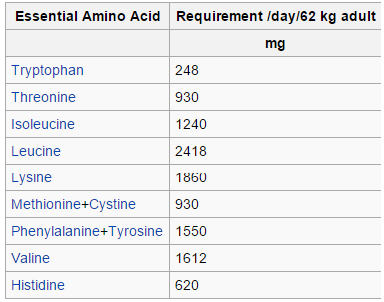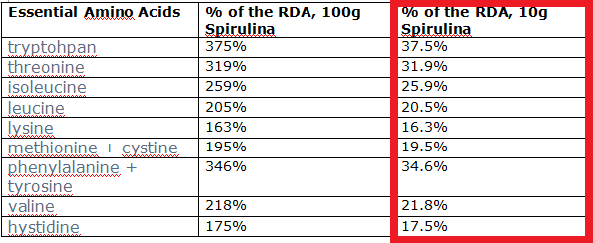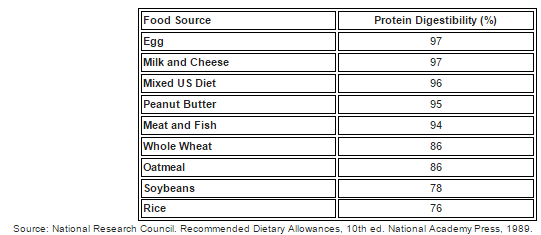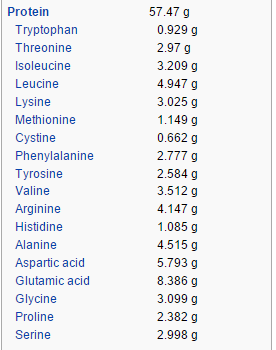Amino acids are the building blocks that make up proteins. Just about every food out there has all 20 amino acids in some quantity, however, not all foods have sufficient amounts. Different amino acid concentrations make proteins from various sources different, and this is one of the reasons why not all proteins are created equal.
So what are the amino acids of spirulina? And how much of each?
The chart below breaks down the protein of 100 grams of spirulina. As you can see its protein content is 57.57g, which is normal, but on the low side (spirulina’s protein content ranges from 55-70% protein).
Out of all these amino acids, the most important for your dietary consumption are the “essential” amino acids. Why? Because your body cannot synthesize these amino acids so it relies solely on getting them from foods.
Spirulina, being a complete protein source, contains all these essential amino acids, which include tryptophan, threonine, isoleucine, leucine, lysine, methionine+cystine, phenylalanine+tyrosine, valine, and histidine.
By looking at the recommended dietary allowance (RDA) for the essential amino acids we can see how good of a source spirulina really is. So take a look at the table below (source – World Health Organization)
These are the recommended dietary allowances of the essential amino acids for a 62kg or 137lb adult. If you compare these values to that obtained in 100g of spirulina you will find that you get WELL OVER the RDA for all of the essential amino acids.
But lets face it. 100 grams of spirulina!? I don’t think anyone is consuming that much per day. 10 grams is more like it. Thats a pretty normal serving, which is a heaping table spoon. So lets take a look these values and see what you can realistically expect to get out of spirulina supplementation.
Well, you are still going to need to get more of the essential amino acids throughout the day to meet the RDA, but one little tablespoon really takes a big chunk out of what you need.
Just look, the lowest value there is lysine, which you will receive only about 16.3%. But still thats just out of 1 tablespoon. The average % here is just over 25% of the RDA.
Beyond this, your body will absorb spirulina’s amino acids very well
This is due to spirulina’s biological makeup. Spirulina contains no cellulose in the walls of its cells. Without cellulose, which cannot be digested, spirulina’s protein is much more easily digested. Its amino acids, which make up its protein, are broken up and absorbed quickly. Due to this and other variables, its protein is anywere from 85-95% digestible.
This ends up being slightly lower than most meats and fish, which tend to range in the mid 90th percentages, but is significantly higher than most vegetable sources. Just to give you a better idea of how it compares take a look at this chart of various other food sources and their protein digestibilities:
Putting it All Together
When you take a look into spirulina’s protein you find that it is “complete” and has a decent amount of all the essential amino acids, and you find that they are easily digested. There are other foods, mainly meats, that have better amino acid ratios and higher protein digestibility ratings, but spirulina beats out the vegetable competition for sure.
Spirulina is definitely a good choice when it comes to its amino acids. Just a tablespoon a day will get nearly 1/4 the RDA essential amino acids out of the way. But thats if you take spirulina powder. Remember there is spirulina tablets and capsules available too.
==> Click Here to find what I consider the top spirulina products <==
I hope you found this article helpful. If you have any questions or comments about spirulina and the amino acids it contains please leave them below. I will get back to you.

